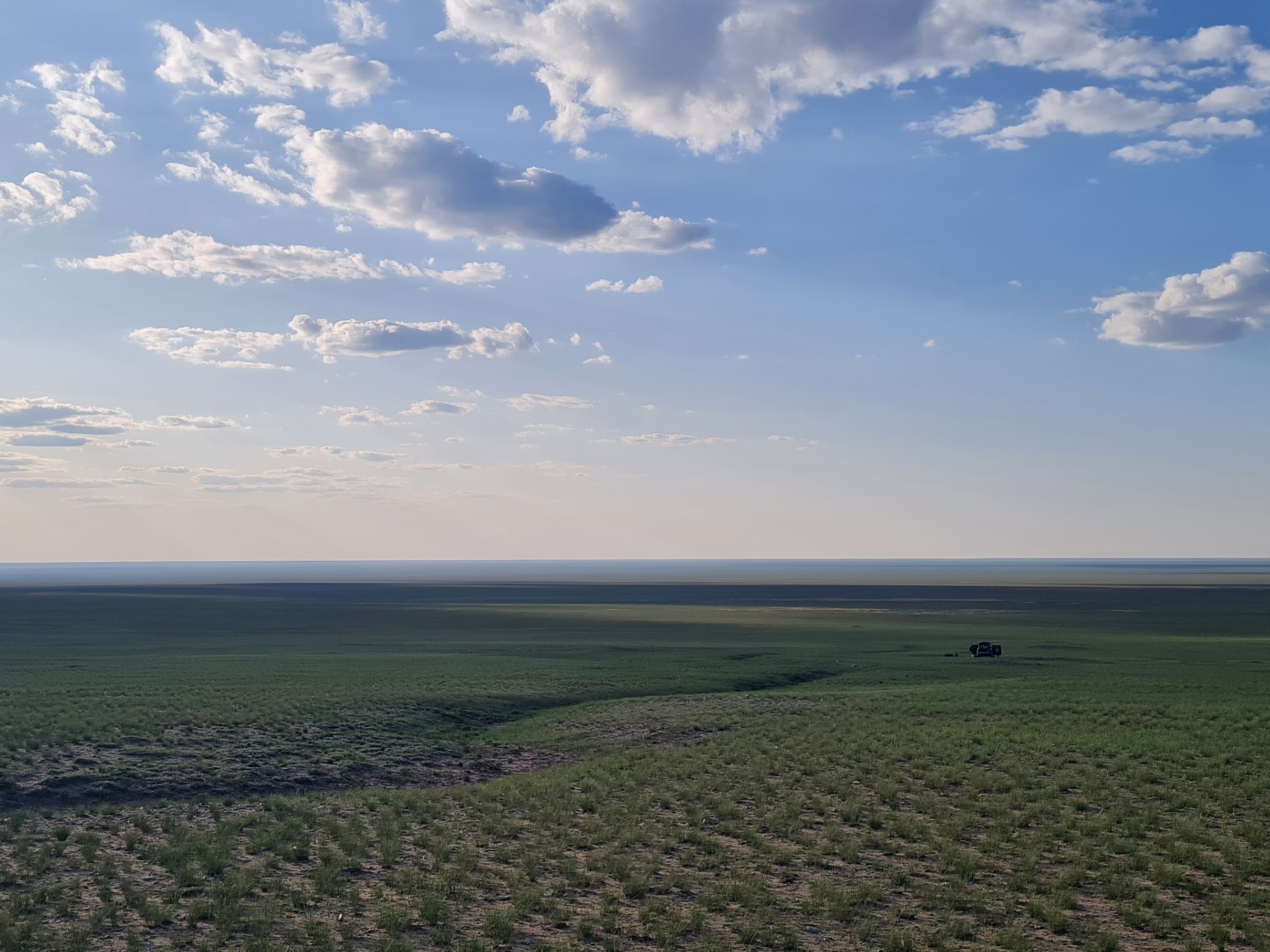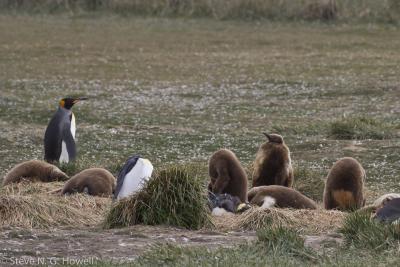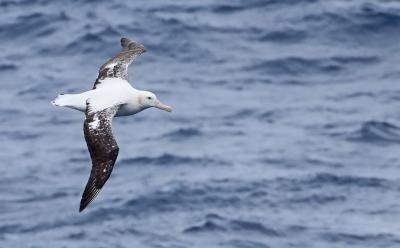Mongolia: The Eastern Steppes
-
May 19-29, 2026
Stephen Menzie
-
May 2028
Stephen Menzie
Tour Price to be Determined
2026
(2024 Tour Price $5,290)
2028
Tour Price to be Determined

Tour Price to be Determined
2026
(2024 Tour Price $5,290)
2028
Tour Price to be Determined
We offer a unique itinerary to the far east of Mongolia, a land of the endless sea of grass, of golden steppes as far as you can see, where the only signs of humans are the tracks we drive on and the occasional nomad’s ger. Out here, there are ornithological discoveries still to be made. The avian influence is Manchurian in origin, and our main targets will be Jankowski’s Bunting, Baer’s Pochard, Siberian Crane, Mongolian Short-toed Lark, Ochre-rumped Bunting, polivanovi Reed Parrotbill and Marsh Grassbird. It’s also just possible that Swinhoe’s Rail can be found here… We’ll be travelling light and camping – there’s no other option on most nights – and covering huge distances by in 4x4s, the majority of it on dirt tracks. However, the vehicles we use are comfortable, our drivers are marvelously proficient, and the tracks are usually smooth going.
In 2026, this tour can be taken in conjunction with Mongolia.
We offer a unique itinerary to the far east of Mongolia, a land of the endless sea of grass, of golden steppes as far as you can see, where the only signs of humans are the tracks we drive on and the occasional nomad’s ger. Out here, there are ornithological discoveries still to be made. The avian influence is Manchurian in origin, and our main targets will be Jankowski’s Bunting, Baer’s Pochard, Siberian Crane, Mongolian Short-toed Lark, Ochre-rumped Bunting, polivanovi Reed Parrotbill and Marsh Grassbird. It’s also just possible that Swinhoe’s Rail can be found here… We’ll be travelling light and camping – there’s no other option on most nights – and covering huge distances by in 4x4s, the majority of it on dirt tracks. However, the vehicles we use are comfortable (Toyota Land Cruisers in 2023), our drivers are marvelously proficient, and the tracks are usually smooth going.
In 2026, this tour can be taken in conjunction with our tour Mongolia.
Day 1: We’ll meet at Ulaanbaatar’s Chinggis Khaan International Airport and begin our all-day drive to the Baruun-Urt region. On the way, we’ll see the more common Mongolian birds, with Red-billed Chough and Daurian Jackdaw along the roadsides, and Black Kite, Steppe Eagle, and Upland Buzzard dominating the skies. Night in Nalaikh.
Day 2: We’ll continue east to an area of sacred hills deep in the steppes. Our destination is the Khalhgol district in Dornod province, the easternmost district in Mongolia. Depending on whether there have been wildfires or not, we’ll either see a sea of gold or a sea of fresh new green. The steppes will be alive with larks, and among the many Mongolian and Asian Short-toed, we should have no trouble finding Mongolian Short-toed Lark. We may also encounter Siberian migrants, as out here the only feature that attracts them are the dirt tracks! Taiga Flycatcher may be the most common, but we should encounter other forest dwellers such as Brown Shrike or Siberian Blue Robin. With very good luck, we may find one or two Oriental Plovers.
We’ll find ourselves truly alone in the wilderness. The landscape is seemingly endless, and from our slightly elevated camping position on the edge of the hills, it spreads out like a vast canvas. If we’re are lucky, we may be treated to one of the world’s great mammal spectacles, the huge herds of Mongolian Gazelle. On our 2023 scouting tour, we estimated the visible herd at over 100,000. We’ll spend two nights camping at Dornod Mongol Biosphere Reserve.
Day 3: A small population of Rufous-backed (Jankowski’s) Buntings was discovered around 2019 in these isolated hills. It was previously thought to be restricted to a handful of sites in northern China and it remains one of Asia’s most endangered birds. After the long drives of the previous days, we’ll spend all day exploring a limited area. Hopefully, our search for the bunting will also reveal northbound migrants sheltering in small, vegetated gullies. Buntings will feature strongly and may include Chestnut, Tristram’s, and Yellow-throated. We may also encounter White’s Thrush. Night camping.
Day 4: Driving further east, we’ll eventually arrive at a wetland complex deep in the steppes where we’ll camp for two nights. The reedbeds here are home to Marsh Grassbird and Reed Parrotbills (here of the northern race polivanovi – sometimes touted as a potential split from birds further south in China), while Ochre-rumped Bunting gives out its simple but pleasant songs from the surrounding marshes. We’ll camp as close to the reeds as we can and may be watching all three from our tents by nightfall! Night camping.
Day 5: We’ll have all day to explore this area, mostly by foot but we’ll also use our vehicles as necessary. The local lakes host good numbers of waterfowl, including Falcated Duck, and we should find White-naped and Demoiselle Cranes, with a chance of the rare Red-crowned Crane. The reedbeds should be alive with perhaps the world’s most easterly Paddyfield Warbler, as well as Black-browed and Oriental Reed Warblers and Bearded Tit. Migrant shorebirds should include Pacific Golden Plover and Marsh Sandpiper, and migrants such as Dark-sided Flycatcher and Arctic Warbler might be hunting along the reed edge. There is at least one record for Swinhoe’s Rail, and while this would require extraordinary luck, considering only a handful of birding visits have been made here, we should probably pack our rubber boots! Night camping.
Day 6: We’ll drive all day, north to and perhaps beyond the town of Choibalsan. Once again, we’ll be passing through extensive steppes, keeping alert for larks, Oriental Plover and migrants. Perhaps a Siberian Buff-bellied Pipit or Dusky Thrush may drop by, and any small patch of water will be worth investigating. Night in Choibalsan.
Day 7: We’ll arrive at Chukh Lake at some point in the day. Our main target will be Baer’s Pochard, a critically endangered duck whose numbers have fallen dramatically at all its wintering sites. Very small numbers are recorded in Mongolia in spring, at mostly random locations, but one or two have visited this area in recent years, and it seems to be fairly reliable. Night camping near Dashbalbar.
Day 8: After birding Chukh Lake in the early morning, we’ll begin the long drive back west. We’ll be passing through the Daurian Steppes, and towards our final destination, the Khurkh Valley. This extensive and unique wetland is of major importance for breeding and migrating cranes. Hooded Crane is regular in the spring, and small flocks may occur. The main prize is the critically endangered Siberian Crane, and this valley is a regular stop for them on their spring migration. Great Bustard, a species that remains in serious decline throughout its range, is also possible. The valley runs roughly north-south and is a major migration route for the more usual Siberian migrants, with many possibilities such as Chestnut-eared and Yellow-breasted Buntings, and perhaps a Japanese Sparrowhawk or Oriental Cuckoo. Night camping near a bird ringing station.
Day 9: We’ll spend the morning birding the Khurkh valley area, then depart in time to arrive in Ulaanbaatar and our hotel for dinner. Night in Ulaanbaatar.
Day 10: The tour concludes this morning with transfer to the airport for international departure, or to continue on to the Mongolia tour.
Note: The information presented below has been extracted from our formal General Information for this tour. It covers topics we feel potential registrants may wish to consider before booking space. The complete General Information for this tour will be sent to all tour registrants and of course supplemental information, if needed, is available from the WINGS office.
ENTERING MONGOLIA: United States and United Kingdom citizens will need a passport, valid for at least six months beyond your date of entry, and with at least one blank visa page, but a tourist visa is not required for stays of fewer than 90 days. The Mongolian Border Agency may collect biometric data (scanned fingerprints) on your arrival.
Citizens of other countries should contact their relevant embassy for advice. In the United States, this is the Embassy of Mongolia at 2833 M Street NW, Washington, DC 20007, telephone: (202) 333-7117 or http://www.mongolianembassy.us
If required by the embassy or visa-granting entity, WINGS can provide a letter for you to use regarding your participation in the tour.
It is always a good idea to take photocopies of your passport and air ticket with you when traveling abroad. They can prove invaluable in helping you get replacements if your original documents are lost or stolen. You should pack the photocopies separately from the originals.
COUNTRY INFORMATION: You can review the U.S. Department of State Country Specific Travel Information here: https://travel.state.gov/content/travel.html and the CIA World Factbook here: https://www.cia.gov/the-world-factbook/. Review foreign travel advice from the UK government here: https://www.gov.uk/foreign-travel-advice and travel advice and advisories from the Government of Canada here: https://travel.gc.ca/travelling/advisories.
HEALTH: The Centers for Disease Control and Prevention (CDC) recommends that all travellers be up to date on routine vaccinations. These include measles-mumps-rubella (MMR) vaccine, diphtheria-tetanus-pertussis vaccine, varicella (chickenpox) vaccine, polio vaccine, and your yearly flu shot.
They further recommend that most travellers have protection against Hepatitis A and Typhoid. Please contact your doctor well in advance of your tour’s departure as some medications must be initiated weeks before the period of possible exposure.
The most current information about travelers’ health recommendations can be found on the CDC’s Travel Health website here: https://wwwnc.cdc.gov/travel/destinations/list
Advisories and recommendations by agencies such as the CDC can, and do, change frequently. It is essential that you contact your own doctor to obtain the latest information on the region you are visiting.
Altitude: The elevation of the tour ranges from approx. 2000 – 3500 feet (approx. 600-1000 meters).
Insects: Biting insects can be encountered, especially around the lakes, but are usually not too much of a problem. Insect repellent (preferably with a high percentage of diethyltoluamide – DEET) will provide adequate protection. Care must be taken, however, to avoid getting the DEET repellent on optical equipment as DEET dissolves rubber and plastic and can damage coated lenses. Camping supply stores and outfitters carry some reasonably effective alternatives, which contain natural products and aren’t corrosive.
Drinking water: Tap water is not safe to drink in Mongolia but we will carry bottled water with us, or use boiled spring water for making tea and coffee.
Smoking: Smoking or vaping is prohibited in the vehicles or when the group is gathered for meals, checklists, etc. While in the field or traveling, use of a smokeless alternative such as nicotine gum is requested. Please do not smoke at short stops while traveling. If you smoke in the field, do so well away and downwind from the group and leave ample time between smoking and getting back into the vehicle. If you are sharing a room with a non-smoker, please do not smoke in the room. If any lodge, accommodation or location where the group is staying or is gathered has a more restrictive smoking policy than WINGS’ policy, the more restrictive policy will prevail. The leader reserves the right to modify this policy if the situation warrants it.
GENERAL NOTE: This tour will spend a lot of time a long way from “anywhere”. In fact, we are the only international company offering this itinerary, and it will certainly give you a taste of the endless sea of grass that makes up the eastern third of Mongolia. We will be travelling in very remote areas with few people and long distances between birding spots. The first day in particular could be very long and completely spent in the cars, so this needs to be born in mind. Although the tour starts at the airport on day one, it is recommended that you arrive a day early and stay in Ulaanbaatar the night before. This will allow you to be more refreshed from the journey and allows for the sad fact that luggage can go missing on international flights. We can easily arrange an earlier arrival and hotel for anyone wishing to do this and can also arrange cultural tours of Ulaanbaatar.
PACE OF TOUR AND DAILY ROUTINE: This tour does not require high levels of fitness or stamina. Most of the walks are easy and short over good ground. Around the lakes, the ground may be wet and uneven with tussocks, so waterproof walking boots or decent rubber boots are recommended. Bear in mind there are no trails, so we will always be birding on grass or dirt. There are no uphill walks.
There will be a lot of driving, and we spend a lot of time in the tour vehicles. Most of the first and last day will be on tarmac roads of varying quality, but the rest of the tour will be almost exclusively on dirt tracks. Most of these are in good condition and our 4x4 vehicles are excellent at providing a comfortable ride. However, there will inevitably be occasional bumps and dips along the way. The birding sites are a long way apart, and some days will be spent mainly driving. We will be stopping along the way to look for birds, but expect some full days driving, especially at the beginning of the tour as our first main birding area is approx. 500 miles (800km) east of Ulaanbaatar. It’s worth mentioning that we are traveling through and birding in very open country devoid of any cover. Impromptu ‘bush stops’ may therefore have to rely on using one of our vehicles as a sort of ‘mobile bush’.
There may be one or two very early pre-breakfast starts but generally, days begin with breakfast at 06:30 a.m. or 07:00 a.m. and usually end no later than 6 p.m. We try to allow an hour or more before dinner and checklist.
We will be travelling with our camp crew. On arrival at a campsite they generally prioritise erecting the toilet tent and kitchen tent, followed by the individual tents. There will be no need for us to help set up camp.
CLIMATE: Weather in Mongolia can be very mixed at this time of year and you need to dress accordingly. Generally it will be warm during the day but it can be very cold (below freezing) at night and in the early mornings. During previous tours we have experienced temperatures ranging from 23F to 100 F (-5C – 37C) Rain and strong wind is possible at almost any time.
CAMPING ACCOMMODATION: We’ll stay in hotels on the first night in Baruun Urt, on the night of Day 6 in Choibalsan, and on the last night back in Ulaanbaatar. The rest of the nights we’ll be camping in tents provided by the ground agents at campsites which they will set up near prime birding locations or, on travel days, at suitable locations along our route. Camping beds are provided and the tents are large enough to stand up in. Bedding is provided in the form of a mattress, sheets, blanket, pillow, pillow case and duvet. You will be issued the same bedding each night of camping. If you wish to, you are welcome to take your own sleeping bag or sleeping bag liner.A sleeping bag will be essential if the temperature does drop below freezing and is therefore highly recommended. The camp beds are just about big enough for our 6’2” (1.85m) leader, but he actually prefers to take a ‘therm-a-rest’-style camping mattress and sleep on the floor. The therm-a rest can also be combined with the provided mattress to form a thicker more comfortable base on the camping beds. Water is available for washing and our ground agents also provide both small and large towels. Our tents are tepee-style, large enough to walk around in and excellent against all but the very strongest winds. You will be required to share a tepee-style tent if you are not paying the single room supplement.
Our crew will erect one or two “toilet tents”, which consist of a sit-down camping-style toilet. They will also erect a gravity-style shower tent and hot water can be provided for this.
FOOD: All the food is carried with us from Ulaanbaatar. The camp cook is very experienced in preparing a variety of meals ‘on the road’ and we are constantly surprised at the quality and variety of the meals provided. Water, coffee and tea are provided by the ground crew. We will also carry beer and soft drinks but probably cannot keep these chilled. Vegetarians can be catered for.
Food Allergies/Requirements: We cannot guarantee that all food allergies can be accommodated’ Participants with significant food allergies or special dietary requirements should bring appropriate foods with them for those times when their needs cannot be met. Announced meal-times are always approximate depending on how the day unfolds. Participants who need to eat according to a fixed schedule should bring supplemental food. Please contact the WINGS office if you have any questions.
This tour is offered every other year, on even years.
We can assist with booking extra nights at our Ulaanbaatar hotel and airport transfers upon request.
Maximum group size is eight with one WINGS leader.



